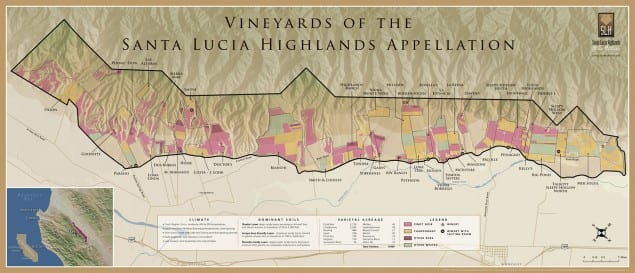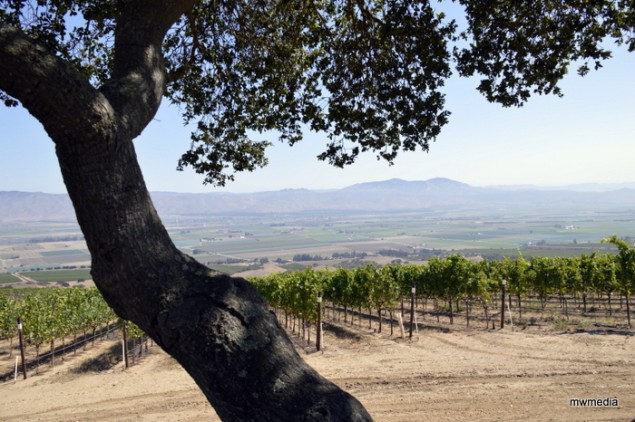The unique climate of cool fog and windy conditions in the Santa Lucia Highlands makes for an especially long grape growing season encouraging great wines in the American Viticulture Appellation.
By Michelle M. Winner

It’s six A.M and my breakfast companions, some lively cormorants and seagulls, are diving among the pilings and rocks into the gray deep of Monterey Bay, California. Whole colonies of birds are circling above as the fog and cool ocean breezes blow onshore. I am about to take a ride some miles inland to learn about the new-ish and not too discovered AVA called Santa Lucia Highlands or SLH, which owes the quality of its wines in part to this very fog and wind.
The AVA of SLH
Rising warm air from the southern end of the Salinas Valley pulls the cool breezes off the Bay southeastward into the valley at the base of the Santa Lucia Mountains. Night fog gives way to sunny mornings and later brisk, warm air currents will reach the Santa Lucia Highlands (SLH). Sometimes winds kick up into a frenzy in the afternoon. But all of this is a good thing in the SLH AVA. The unique SLH climate of cool fog and windy conditions in a semi-arid environment make for an especially long grape growing season encouraging full phenolic development in this American Viticulture Appellation.

The vast, dusty valley floor of the Salinas Valley is a major agricultural growing region for lettuce, peppers, kale, broccoli and other vegetables because of underground aquifers. In the 1790’s Spanish missions successfully cultivated vinifera here to provide wine for the table and Catholic mass. Not too long ago cattle and horse ranches dotted the hills. But it wasn’t until the 1980’s that the AVA SLH was proposed, finally receiving the designation in 1991 due to the efforts of many valley wine pioneers including Nicky Hahn, Rich Smith, and Phil Johnson. The SLH AVA is not a large one. It is less than eighteen miles long and much of the 22,000 total acreage is un-plantable mountain range. Over 50 wineries have six thousand acres planted; 3,100 in Pinot Noir and 2,000 in Chardonnay, with the remaining acreage in Riesling, Syrah, Pinot Gris, Viognier, Sauvignon Blanc, Malbec, Gewurtztraminer, Grenache Noir, Muscat Canelli, Roussanne, Grenache Blanc and a few other varieties.
The Grapes
Some of the Santa Lucia Highlands area growers and winemakers planted Cabernet Sauvingnon in the 1970’s and 1980’s, following the Napa Valley’s push to meet the consumer’s desire for big “ steakhouse reds.” But the fruit proved hard to ripen here. Assessing the local conditions, more attention began to be focused on the fog that rolled in overnight from the Monterey coast and the winds that chased it up the100 mile long Salinas Valley. Growers found that the grapes most suited for the SLH were clearly the cool evening, hot day-loving Pinot Noir and the climate-adaptable Chardonnay. After some not-so-great vintages SLH winemakers realized that this was not the place to grow the Bordeaux varietals and tore most of them out, planting the Burgundian grapes with marked success.
As for the current harvest, longtime SLH grape grower and winemaker Rich Smith says that the 2015 harvest pleases most winemakers but a grower’s point of view is a bit different. “I get paid by the ton and this year the grapes are light. The grapes are also smaller, usually most vineyards are at ¼ lb per bunch count but this year they are 1/8lb.” Mr Smith says. However there are benefits to winemakers this year as Mr. Smith goes on to say, “The skin to juice ratio is way up, so nirvana for winemakers. “ He is referring to the flavors residing in these thicker skins as hotter, dryer weather patterns along the West Coast from Washington to California have brought an early harvest. In some places like the Willamette Valley in Oregon, Chardonnay was being picked as much as three weeks early.
The Hahn Family Winery in SLH
I visited Hahn Family Winery up on their SLH acreage at Smith Ranch headquarters. Here and in the rest of Hahn’s vineyards in the Highlands, the planting and waiting has paid off. In particular, Hahn’s single vineyard Lucienne Estate brand is a velvety group of Pinot Noirs some with notes of pine or black sage and layers of spice depending of course if they are from the Lone Oak , Doctor’s, Smith, or Hook vineyard. There is also an expressive Lone Oak Chardonnay that exhibits bracing minerality and faint citrus notes that I enjoyed. For another of Hanh’s brands, SLH, Hahn produces bottles of Pinot Noir, Chardonnay, GSM blend (Grenache, Syrah, Mourvedre) or Pinot Gris in this AVA. As one might surmise, not all parcels of land here produce the same flavor profile in the wine because of the differing micro-climates, wind exposure and terroir within this AVA. But the wines are also influenced by the flora here such as the black sage or the pine that I mentioned.

One of Hahn’s estate small-production wines, the Lucienne Doctor‘s Vineyard Pinot Noir, survives on perhaps the bleakest plot of vineyard. Hahn’s Andy Mitchell, Director of Viticulture explains the magic that happens there, “The highlands winds get stronger in the afternoon and here on this particular piece of land it is the most intense. The grapes are subjected to a harsher condition but this makes the skins thicker and that produces more flavor.” To that I would agree as I found that an aged Doctor’s Pinot Noir to be an elegant wine.
In a layman’s hands grapes can produce wine of singular note with little sophistication. But given the combination of excellent grapes, extended growing season to slowly develop the flavors, a talented team of winemakers, and the benefit of a unique environment; the grapes manifest into noteworthy vintages here in SLH. In this region there are not many tasting rooms and certainly no grandiose works of art on the vast lawns of a conglomerate’s property competing for the wine tourist. SLH is for serious wine lovers who want to enjoy the discovery of some great wine.

At Hahn, credit Director of Wine making Paul Clifton and Winemaker Greg Freeman. While wine tasting with Mr.Clifton, he breaks down his philosophy for me with a twinkle in his eye, “Pick the grapes when they are ready and the wine will be made the way it wants to be made.” We go over to barrel taste in the simple barn-style barrel room cooled by the natural breezes of the SLH blowing through the open doors where Mr. Freeman deadpans, “ I guess when we get extra money we buy more barrels, we don’t spend it on facilities.” Not hardly.
www.hahnwines.com












